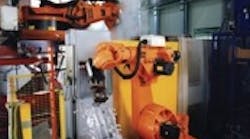By looking at the automation used in a single process, such as robotic ladling, it's possible to see how several benefits that larger operations have enjoyed are working their way into smaller operations.
Automated ladling allows for greater part integrity. By controlling the speed and volume of shot being poured into the sprue, robots give manufacturers the control necessary to reduce the amount of gases introduced into the part. A sloppy aluminum pour that doesn't fill the sprue completely will draw oxygen and hydrogen into the metal, creating aluminum-oxide bubbles and making the casting more porous, reducing its integrity. In an automotive part such as a break caliper, the aluminum-oxide pores create spaces within the part where oil can seep through and reduce the part's effectiveness.
Robots allow for the automation of the seventh axis ,or ladle, making pouring more consistent, reducing waste, and increasing part integrity by allowing more ‘angles of attack' when pouring and dipping. Automation also allows manufacturers to dip lower into the furnace before it needs to be refilled, reducing cell downtime. Additionally, by combining the six axes of an articulated robot with the seven-axis motion of a robotic ladle, it's possible to create more intelligent paths through a work cell by using steadier motions to and from the furnace. This increases throughput while reducing waste from spilling.
Material cost savings. Robotic automation can reduce a metalcaster's material costs in two ways:
- By creating products with greater metal integrity, less metal will be needed to be re-worked, reducing wasted throughput time.
- Robotics minimizes the amount of spilled metal, by being able to pour more consistently than individuals who may tire as a grueling day wears on. For example, if a manufacturer pours 100 lb. of metal an hour spilling 10% over the course of an eight-hour shift, and operations run 24 hours/day, 365 days/year, a manufacturer can lose over 40 tons of metal per year — wasting hundreds of thousands of dollars of metal.
Being inherently flexible, robots can rotate between multiple furnaces and work cells to handle multiple work stations. Not only can robots handle multiple tasks more consistently over a longer period of time than manual labor, robots also increase the pouring ranges from grams to shots over 50 kg, as well as handle secondary processes from dipping to gripping of parts.
Smaller-run foundries can justify investing in automation, because the next step in automated ladling are manually guided robots for prototype, pre-series, and small-series production operations.
Programming the robots' movements and influencing pouring variables traditionally demanded a great deal of operator know-how, making these types of cells uneconomical for small-production volumes regardless of the benefits of automation. The development of safe robot technology allows workers to guide the robot manually using a joystick through all the necessary process motions — including the pouring curve itself — virtually eliminating the programming labor costs. Foundry workers could now teach all points of the pouring motion, using the joystick, right through to actually pouring the aluminum. This is a simple system based on practical experience and requiring no programming. The path and pouring curve are simply saved after the operation has been completed, and can be repeated in production.
Kevin Kozuszek is director of marketing for KUKA Robotics. Visit www.KUKArobotics.com for more information.









